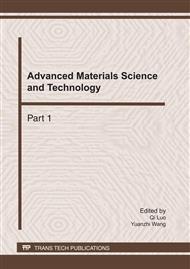p.183
p.189
p.195
p.201
p.206
p.212
p.220
p.226
p.230
Self-Oscillating Behaviors of Negatively Charged Polymer Chain Induced by the Belousov-Zhabotinsky Reaction
Abstract:
In this paper, we studied the effect of the temperature and the initial concentration of sodium bromate (NaBrO3) on the aggregation-disaggregation self-oscillation for a polymer chain. The polymer chain consisted of N-isopropylacrylamide (NIPAAm), Ru catalyst of the BZ reaction and Acrylamide-2-methylpropanesulfonic acid (AMPS) as a solubility control site. The concentration of sodium bromate and the temperature significantly affected the self-oscillating behavior and the period of the aggregation-disaggregation self-oscillation. Moreover, the amplitude of the aggregation-disaggregation self-oscillation of the AMPS-containing polymer solution decreased with time. The damping behavior is originating from the increase in the size of the polymer chain. In addition, this study clarified that the period of the self-oscillation of the AMPS-containing polymer solution in the strongly acidic condition was significantly shorter than that in the acid-free condition.
Info:
Periodical:
Pages:
206-211
Citation:
Online since:
January 2011
Authors:
Price:
Сopyright:
© 2011 Trans Tech Publications Ltd. All Rights Reserved
Share:
Citation:


